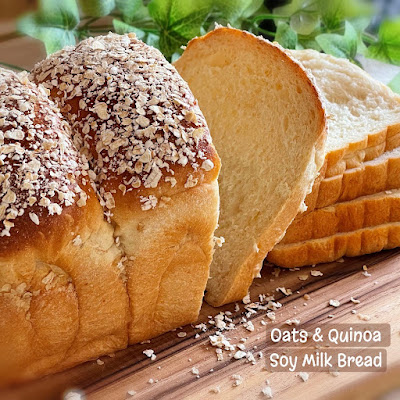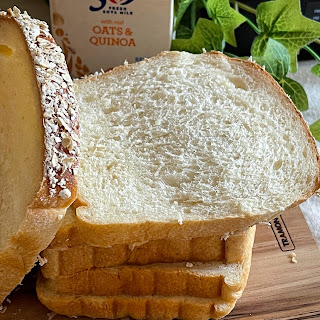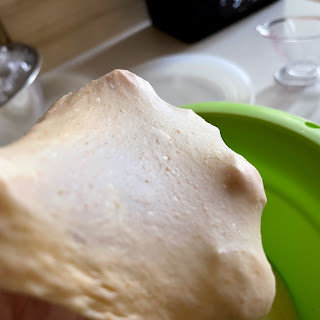A soy milk bread using oats and quinoa soy milk and added a small amount of multigrain soy pulp. Sweet, soft and chewy texture bread which I loved 😋
The same bread recipe can be divided into 4 small loaves and baked in two 1L Jamie Oliver pans (17.5x10x9 cm) with shorter baking time 🍞🍞🍞🍞
Yield: one loaf of bread
Pan size: 21x13x10 cm Jamie Oliver 1.5L bread pan
Raw dough weight: 656g
Baking temperature: Preheat oven to 180℃, middle/lower rack, bake at 180℃ for 15 minutes, reduce to 170℃ for 10~15 minutes, turn off oven and continue to bake for 5 minutes.
Sweet Stiff Levain (SSL)
Ingredients
38g cool boiled water
15g raw sugar
20g natural yeast, 100% hydration*
80g unbleached bread flour
* 20g natural yeast can be replaced by 10g bread flour + 10g water + 1/8 tsp instant dry yeast
Let the sweet stiff levain stands in room temperature for about 8 hours, or triple in volume, before adding to dough.
Oats & Quinoa Soy Milk Dough
Ingredient
A
210g bread flour
20g spelt flour/plain flour
40g raw sugar
1g instant dry yeast
B
150~154g sweet stiff levain
30g multigrain soy pulp *
20g beaten egg
120g oats & quinoa soy milk
30g whipping cream, cold
10g water, cold (to be added depending on dough condition)
C
4g low-sodium fine salt
D
20g unsalted butter, softened
* 30g multigrain soy pulp can be replaced by about 10g spelt flour, 10g oats & quinoa soy milk & 15g cold water. Multigrain soy pulp was made up of organic soy beans, almonds, red kidney beans, black beans, split green peas, walnut, pumpkin seeds, mung beans and pandan leaf.
Directions
Knead the dough following your preferred method till reaching window pane.
1. Mix Ingredient A in a mixing bowl.
3. Knead the dough using an electric hand mixer fitted with a pair of dough hooks till the dough is smoother. Knead in Ingredient C.
4. Knead in Ingredient D,
till the dough is smoother and a bit glossy.
5. Perform about 200 sets of "slapping and folding" till the dough is elastic (the dough can stretch to about 30 cm without breaking).
The dough can also be pulled out into a thin membrane, known as window pane stage.6. Shape into a ball
Store the dough in the fridge for about 12 to 16 hours, or overnight to undergo cold fermentation.
Turn out the dough onto a floured work top. Deflate the dough, divide into 3 portions, and shape into 3 balls. Cover with an inverted mixing bowl, and rest for 15 minutes.
8. Roll out the dough to about 1 cm thick.
Flip over the dough, and fold in the two wings, overlapping each other.
Roll flat to achieve an even thickness. Finally, roll up like a swiss roll.
End of 105-minute second proofing, or till the dough almost reaching the rim of the pan👇
9. Start to preheat oven to 180℃ for about 10 minutes. While waiting, brush beaten egg over the top of the dough.
10. Bake at 180℃ for 15 minutes, reduce to 170℃ for 10~15 minutes, turn off oven and continue to bake for 5 minutes
 |
| Picture for illustration |
10. Remove the hot bread from the pan after leaving the oven, and rest on a wire rack to cool down.
11. After the bread has completely cooled down, cut and enjoy 🍞 😋

































No comments:
Post a Comment
I love seeing your comment and sharing it with other readers. Your comment would be published after moderation. Thank you :)